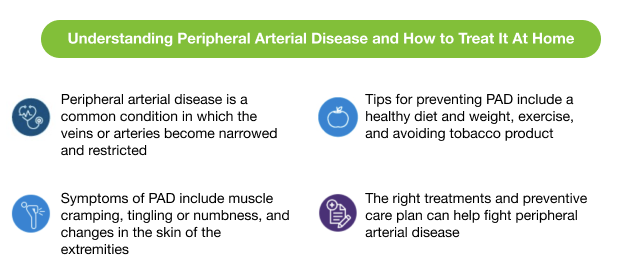
Learn more about peripheral arterial disease, who’s at risk, and how you can implement simple lifestyle changes to help treat and prevent it.
Approximately 6.5 million people in the U.S. aged 40 and older have peripheral arterial disease, and early detection is critical in preventing the disease from progressing and causing major complications. It can be difficult to spot the symptoms, and many sufferers write them off as something else, but understanding this disease and whether you may be at increased risk can help you take control of your treatment and preventive care. For those at risk or who have already been diagnosed with peripheral arterial disease, there are several treatment options to discuss with your doctor, but many of them include simple lifestyle changes you can implement at home!
In this article, we’ll discuss the details of peripheral arterial disease, how to determine if you’re at risk, and what you can do to lower your chances of harmful progression.
What is peripheral arterial disease?
Peripheral arterial disease (PAD) is a common condition in which the veins or arteries become narrowed and restricted, lessening blood flow to the arms and legs. A common cause of PAD is fatty plaque buildup in the arteries, which may result in blood clots and limit the supply of oxygen flowing to the arms and legs.
There are several risk factors that can increase your chances of developing peripheral arterial disease, including:
- High cholesterol
- Diabetes
- High blood pressure
- Atherosclerosis
- Smoking
- Age (those above 60 are most at risk)
Many people mistake the symptoms of peripheral arterial disease for something else. Knowing your risk level can help you keep an eye out for common symptoms. This allows you to better determine the steps you need to take to treat or prevent PAD.
Common Symptoms of PAD
Early detection of peripheral arterial disease is key in preventing it from progressing too far, so understanding the symptoms is crucial in allowing sufferers to determine their risk. Common symptoms of PAD include:
- Muscle cramping in the lower half of the body
- Pain in extremities when performing everyday tasks, such as walking or writing
- Tingling and numbness in the extremities
- Weakness and weak pulse in legs
- Cold feeling in feet/legs, especially when isolated to one side
- Skin color changes/shiny skin on the lower extremities
- Painful sores on lower extremities that won’t heal
- Hair loss on the legs
Allowing peripheral arterial disease to progress can lead to the worsening of these symptoms. The most serious complications that can arise from PAD include stroke and heart attack resulting from plaque buildup and critical limb ischemia, which can result in the loss of an affected limb.
Tips for preventing peripheral arterial disease
The symptoms and risk factors of PAD can be severe, but in many cases, prevention can be as simple as implementing a few healthy lifestyle changes that will help increase your chances of preventing this disease or managing the progression in those who have already been diagnosed. Check out our 5 tips to help you manage peripheral arterial disease:
- Engage in physical exercise:Getting enough exercise is a significant factor in preventing and managing PAD. Your doctor may recommend physical therapy or supervised physical activity treatments, or you can engage in low-impact exercise at home. Walking is a great way to get your body moving without causing pain from overexertion.
- Enjoy a healthy diet:Sticking to a generally healthy diet is very helpful in preventing peripheral arterial disease. It’s important to incorporate foods high in protein, fiber, and potassium and limit your intake of sodium, trans and saturated fats, and red meat. Try to include foods like fruits, leafy green vegetables, whole grains, lean chicken and fish, and calcium-rich, low-fat dairy products.
- Maintain a healthy weight:Obesity can increase your risk of developing PAD, so maintaining a healthy weight is imperative in taking control of your treatment. You can determine a healthy weight for your body type by calculating your BMI or consulting your physician.
- Refrain from smoking and using tobacco products: Using tobacco products can significantly increase your risk of this disease and many other health issues, including heart attack and stroke. Quitting smoking can help slow down the effects of PAD on your body and prevent other cardiovascular diseases.
- Manage other related health issues: There are many other diseases and health issues that contribute to the risks and progression of PAD, including high blood pressure, high cholesterol, and diabetes. By taking steps to keep any of these related health concerns at bay, you can also help prevent or manage peripheral arterial disease.
Implementing these simple, healthy lifestyle changes can help you properly manage your risk and symptoms of this disease, but it’s also necessary to consult your doctor to determine if further treatment options may be necessary for you.
Manage your risks of peripheral arterial disease with ModRN Health
Finding the proper treatment or preventive care plan for PAD has never been more convenient than with ModRN Health. ModRN Health’s program helps you identify the best treatment options in your area that fit your budget and lifestyle. You’ll also have access to helpful information on medications, side effects, and other risk factors that may affect you, as well as a long list of additional program benefits, including:
- Discounts of up to 90% on prescription medications
- Easy to use mobile app for iOS and Android
- Lucrative rewards program
- An easier way to manage your prescription medications
- Healthcare information hub
- Services available in both English and Spanish
Find out more about ModRN Health and gain easy access to the best and most affordable healthcare, plus SMS and email reminders to help you stay on top of your overall health.








